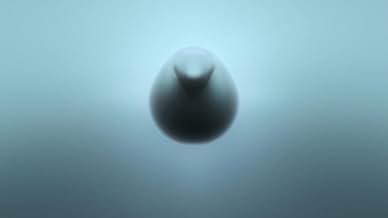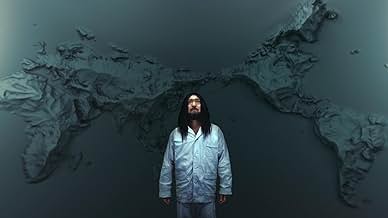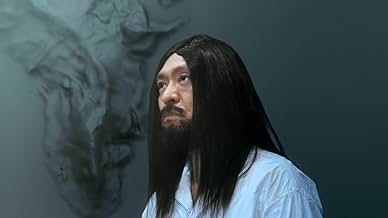IMDb-BEWERTUNG
6,9/10
4768
IHRE BEWERTUNG
Füge eine Handlung in deiner Sprache hinzuA man wakes up in a white room empty other than buttons on the walls, he must find out which button to push to get what he wants.A man wakes up in a white room empty other than buttons on the walls, he must find out which button to push to get what he wants.A man wakes up in a white room empty other than buttons on the walls, he must find out which button to push to get what he wants.
- Regie
- Drehbuch
- Hauptbesetzung
- Auszeichnungen
- 5 Nominierungen insgesamt
Lilian Tapia
- Antonio's Mother
- (as Lillian Tapia)
Matcho Panpu
- Tequila Joe
- (as Misuteru Kakao)
Dick Togo
- El Super Demonio
- (as Dick Tôgô)
Empfohlene Bewertungen
How can I explain such a simple yet complex film such as Symbol? It's not easy, but I'll give it a try.
Symbol see-saws between two stories and is shown in three chapters which are labeled Education, Implementation and Future. There's the story of an out-of-shape Mexican wrestler known as "Escargot Man" as he prepares for a title fight in some tiny dusty little village. And simultaneously, there's the story being told of a Japanese man who awakes to find himself in a large, all white rectangular room with no doors or windows.
Just how are these two stories connected? The answer is an existential journey into the energizing and inventive script of Matsumoto. For those who have seen his first feature Big Man Japan, in where a solitary middle-aged man periodically transforms into a giant to defend Japan from an array of monsters, you might have a little clue as to what you're getting into with Symbol. Let me assure you right now that Symbol is definitely its own monster, and perhaps one that will make both fans and newcomers to Matsumoto's work say WTF.
Perhaps the best film I could compare Symbol to would be Stanley Kubrick's sci-fi masterpiece, 2001: A Space Odyssey. Yes, it's a bold comparison, but an apt one as well. Just substitute Kubrick's towering monolith and epic wormhole sequence for Hitoshi Matsumoto's room full of baby penises and a penis wall climbing ascent into the future and you're basically looking at the same film.
Symbol see-saws between two stories and is shown in three chapters which are labeled Education, Implementation and Future. There's the story of an out-of-shape Mexican wrestler known as "Escargot Man" as he prepares for a title fight in some tiny dusty little village. And simultaneously, there's the story being told of a Japanese man who awakes to find himself in a large, all white rectangular room with no doors or windows.
Just how are these two stories connected? The answer is an existential journey into the energizing and inventive script of Matsumoto. For those who have seen his first feature Big Man Japan, in where a solitary middle-aged man periodically transforms into a giant to defend Japan from an array of monsters, you might have a little clue as to what you're getting into with Symbol. Let me assure you right now that Symbol is definitely its own monster, and perhaps one that will make both fans and newcomers to Matsumoto's work say WTF.
Perhaps the best film I could compare Symbol to would be Stanley Kubrick's sci-fi masterpiece, 2001: A Space Odyssey. Yes, it's a bold comparison, but an apt one as well. Just substitute Kubrick's towering monolith and epic wormhole sequence for Hitoshi Matsumoto's room full of baby penises and a penis wall climbing ascent into the future and you're basically looking at the same film.
Challenges many of the most basic philosophical assumptions about god, heaven, and hell. If you ever wondered about your own impact on others and your ability to do good works.. Or wondered if god could evolve eventually, there is so much to chew on. Imagery as diverse as clowns, Mexican wrestling, and the symbols of Japanese culture flutter as butterfly wings with the strobe and flicker of film infecting NOT only as genius can from the other side of the planet. The layering of thought and ideas is very satisfying compared to typical American films. I am not surprised that all but one of the reviews even gave an accurate summary. This can be a complex film, but not necessarily. A creative child couldn't help being charmed by the poetic surface of action and color. A stunning treat.
I was fortunate enough to catch this movie at a screening during the Copenhagen film-festival last month, and when I went to see it, I didn't really know what to expect, so imagine my surprise and joy, when I found out that the plot went something like this...
First, we begin with a scene in Mexico, where we see a small family eating breakfast.. nothing extraordinary in that, except that the father is wearing a full-face wrestling-mask, like the famous Mexican wrestler Santos (or for the mainstream-audience, like The Gimp from "Pulp Fiction"), and is suddenly picked up by a foul-mouthed woman dressed as a nun, who drives him to town, where the night's big fight is going to take place.
Then, cut to a Japanese man, waking up in a completely empty white room, not knowing how or why he got there, he screams to get some help and attention. But all he sees is something that looks like a button in the wall.. when he presses it, hundreds of naked angel-boys appear before him, only to disappear back into the wall..except their penises! He then proceeds to press the penises, and finds out that something mysterious happens every time he does so! Holes open in the walls, and random things are thrown into the room, be it furniture, gadgets, food, or even living things! All that happens inside the room is apparently a personal voyage for the man, but it also effects other people's lives at the same time, most notably the Mexican wrestler and his family, which we discover near the end of the film. But it really is something that should be watched to be completely understood - and even then, it's not even certain that you'll be able to understand what happened - or why.
Highly recommended film. Very unique and entertaining throughout, even though the last fifteen minutes get really bizarre and too artsy for my taste. This movie is not to be missed. You will probably never see anything quite as weird and funny like this. 8/10
First, we begin with a scene in Mexico, where we see a small family eating breakfast.. nothing extraordinary in that, except that the father is wearing a full-face wrestling-mask, like the famous Mexican wrestler Santos (or for the mainstream-audience, like The Gimp from "Pulp Fiction"), and is suddenly picked up by a foul-mouthed woman dressed as a nun, who drives him to town, where the night's big fight is going to take place.
Then, cut to a Japanese man, waking up in a completely empty white room, not knowing how or why he got there, he screams to get some help and attention. But all he sees is something that looks like a button in the wall.. when he presses it, hundreds of naked angel-boys appear before him, only to disappear back into the wall..except their penises! He then proceeds to press the penises, and finds out that something mysterious happens every time he does so! Holes open in the walls, and random things are thrown into the room, be it furniture, gadgets, food, or even living things! All that happens inside the room is apparently a personal voyage for the man, but it also effects other people's lives at the same time, most notably the Mexican wrestler and his family, which we discover near the end of the film. But it really is something that should be watched to be completely understood - and even then, it's not even certain that you'll be able to understand what happened - or why.
Highly recommended film. Very unique and entertaining throughout, even though the last fifteen minutes get really bizarre and too artsy for my taste. This movie is not to be missed. You will probably never see anything quite as weird and funny like this. 8/10
Symbol is a wonderful tale of the harsh reality of life along a man's quest to reach absolution and his trail through life.
The director uses explicit visual aids to guide us through the materialistic needs of an everyday Japanese man and the things he must do to acquire them by forfeiting his freedom. Following the path of
maturity, he, whose name we will never learn reaches a point were mere material pleasure is not enough and needs to learn what it is like to be free. During this hard and long journey he will find himself doubting and forsaking everything. Only then will he be able to
slide open the door to real freedom and find himself as a new god. But still unable to shed his true human skin, he will influence the lives of people whose existence he is not even aware of.
Symbol is able to reach down and touch you in places that only religion was able to before. It is breathtaking up to the very last second.
The director uses explicit visual aids to guide us through the materialistic needs of an everyday Japanese man and the things he must do to acquire them by forfeiting his freedom. Following the path of
maturity, he, whose name we will never learn reaches a point were mere material pleasure is not enough and needs to learn what it is like to be free. During this hard and long journey he will find himself doubting and forsaking everything. Only then will he be able to
slide open the door to real freedom and find himself as a new god. But still unable to shed his true human skin, he will influence the lives of people whose existence he is not even aware of.
Symbol is able to reach down and touch you in places that only religion was able to before. It is breathtaking up to the very last second.
Many viewers may find this film or the main character quite idiotic or stupid but those who enjoy physical comedy should get a lot out of it.
A very creative and imaginative concept with man in bright spotted pyjamas trapped in a white walled room. On the walls are hundreds of 'buttons'.
With no visible way out of the room, the man becomes desperate and curious and one by one begins to press the buttons, with each button delivering odd 'products' and 'ojects' that are seemingly no help to him getting out of the room.
At the same time, a parallel storyline runs of the real world, with an underdog Mexican wrestler getting ready for a bout.
The two story lines come together with mixed results.
I found the film to be very entertaining although was a little disappointed with the third act.
Funny and offering something different than the usual Apatow 'hits' churned out by Hollywood.
Anyone who likes early Jim Carrey style physical slapstick might enjoy this.
A very creative and imaginative concept with man in bright spotted pyjamas trapped in a white walled room. On the walls are hundreds of 'buttons'.
With no visible way out of the room, the man becomes desperate and curious and one by one begins to press the buttons, with each button delivering odd 'products' and 'ojects' that are seemingly no help to him getting out of the room.
At the same time, a parallel storyline runs of the real world, with an underdog Mexican wrestler getting ready for a bout.
The two story lines come together with mixed results.
I found the film to be very entertaining although was a little disappointed with the third act.
Funny and offering something different than the usual Apatow 'hits' churned out by Hollywood.
Anyone who likes early Jim Carrey style physical slapstick might enjoy this.
Wusstest du schon
- VerbindungenReferences Nip/Tuck: Schönheit hat ihren Preis (2003)
Top-Auswahl
Melde dich zum Bewerten an und greife auf die Watchlist für personalisierte Empfehlungen zu.
- How long is Symbol?Powered by Alexa
Details
Box Office
- Weltweiter Bruttoertrag
- 5.033.714 $
- Laufzeit
- 1 Std. 33 Min.(93 min)
- Farbe
- Sound-Mix
- Seitenverhältnis
- 1.78 : 1
Zu dieser Seite beitragen
Bearbeitung vorschlagen oder fehlenden Inhalt hinzufügen






















